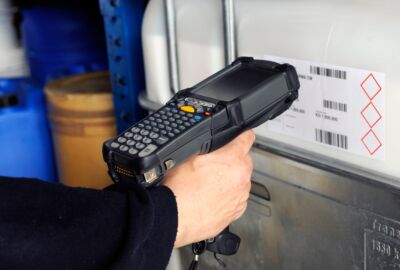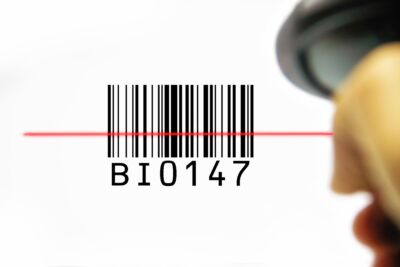An inventory management system is an essential element for any business that works with products or frequently used equipment. Many companies will attempt to track inventory items using spreadsheet systems that require manual entry, perhaps believing that a more advanced option will be an expensive investment and that their inventory volume is too low to justify the cost. In reality, a barcode inventory control is appropriate for any size business and can save your company money.
Barcode Systems Are Simple
 Barcodes manage inventory effectively because the system is easy to use. Each barcode is connected to a specific inventory item and tracks real-time inventory data that you set, such as stock levels, item location and vendor information. To access the information, all a person has to do is scan the barcode on the item and the software pulls up the details. Using the system takes minimal training, allowing access to employees at any level.
Barcodes manage inventory effectively because the system is easy to use. Each barcode is connected to a specific inventory item and tracks real-time inventory data that you set, such as stock levels, item location and vendor information. To access the information, all a person has to do is scan the barcode on the item and the software pulls up the details. Using the system takes minimal training, allowing access to employees at any level.
Improve Inventory Accuracy
When dealing with large volumes of inventory, such as in a distribution center, products and equipment that go missing or are overlooked can be a real problem. If tracking inventory by hand, companies must factor in a certain amount of inaccuracy due to human error. Numbers could be typed in wrong, products may be miscounted or someone may forget to log something.
Using a barcode inventory system allows each item, or case of items, to be scanned in as it arrives and keeps track of where the product is located. This is a game-changer for supply chain management because it’s possible to see where a product is at any given time, whether in transit to the store, on the shelf or shipped out to a customer.
For inventory management systems that handle on-site equipment and tools, barcode inventory control allows the company to track who has what, making it clear who to approach when company property is misplaced.
Barcoding Inventory Is Fast and Cost-Effective
Although implementing barcodes into inventory control systems requires the purchase of barcode scanners and inventory management software to organize the information, a barcode system can pay for itself over time. Scanning barcode labels can be done quickly and requires very little skill, saving the company money on skilled labor for product intake and management.
Having accurate inventory records also reduces lost merchandise or equipment and can help identify issues with theft by highlighting the last location of missing items. Finally, using barcodes for inventory management helps improve the customer experience, allowing employees to instantly look up if a product is in stock, whether more is on its way or if an ordered item has already left the store.
A Barcode Inventory System Is Versatile
 There are several different types of barcodes to choose from, and they each have their own strengths and limitations. This makes this method achievable for all types of inventory counts, whether physical or digital. Different barcode types are capable of managing varying levels of product information.
There are several different types of barcodes to choose from, and they each have their own strengths and limitations. This makes this method achievable for all types of inventory counts, whether physical or digital. Different barcode types are capable of managing varying levels of product information.
Barcode Types
- Universal product code (UPC): A UPC is a barcode provided by the manufacturer, identifying that product for every retailer.
- One-dimensional barcode: As the original style, one-dimensional barcodes work by differentiating products using the size of parallel lines and the spaces between them.
- Two-dimensional codes: These barcodes are capable of storing a greater amount of information and utilize the arrangement of rectangles to create unique identifiers. Data matrix codes are the most common example of this.
- QR code: QR codes are used most often as a marketing tool rather than for inventory management and link to information that’s posted online.
Along with having multiple types of barcodes available, there are also a variety of ways to connect them to a product. Barcodes can be printed directly, fixed with a label or connected with an appropriate tag.
How to Implement a Barcode Inventory Management System
- The initial setup requires some time investment to define each stock-keeping unit (SKU) by the product it represents and the information that will be tracked. Every product type should have a unique SKU, factoring in all variants and necessary information, such as expiration dates and item descriptions.
- The next step is to choose the inventory management software to complete your barcoding system. The amount of information tracked and the level of depth in potential information can vary between different barcode software, so it’s important to choose a software system that meets the company’s current and anticipated needs.
- Now select which type of barcode will work best for inventory control. This choice will determine which kind of barcode scanner will be used and how each barcode label will be generated. Follow this up by integrating the barcode system with whatever point of sale (POS) system is currently in place.
- The last step is to create barcodes and attach them to your tracked items. There are several options for doing this, including sticker labels, direct printing and hanging tags. The type of label needed will often depend on the intended purpose of the barcode. For example, using an in-house barcode printer or online barcode generation is a suitable option for tracking merchandise being sold. For inventory control of something that requires scanning barcodes frequently, such as tools that need to be checked out, a more durable tag is a better option.
Keep Track of Company Assets
If you want to have better control over the equipment and tools needed to run your business, purchasing our custom labels and tags can provide you with the barcode inventory control you need. Metal Marker Manufacturing Company offers durable metal barcode tags that are designed to last years, so you can stop writing off missing items because someone forgot to log their locations. Contact us today by calling 1-800-428-0095 and let us provide you with the inventory tracking tools you need to protect your assets.